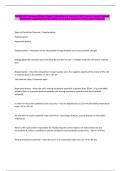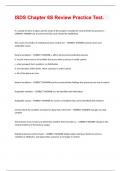NURS 5315 Advanced Patho Exam 1 | Questions & Answers (100 %Score) Latest Updated
2024/2025 Comprehensive Questions A+ Graded Answers | With Expert Solutions
Steps of the Action Potential - Depolarization
Repolarization
Hyperpolarization
Depolarization - movement of the intracellular charge towards zero (more positive charge)
Voltage gated Na channels open and allow Na to enter the cell -> voltage inside the cell moves towards
zero
Repolarization - Once the intracellular charge reaches zero, the negative polarity of the inside of the cell
is restored back to its baseline of -70 to -85 mV
-Na channels close, K channels open
Hyperpolarization - when the cell's resting membrane potential is greater than -85mV. Is less excitable,
because there is a greater distance between the resting membrane potential and the threshold
potential.
In order for the action potential to be sucessful - t has to depolarize by 15-20 mV (threshold potential) to
reach -55 to -65 mV.
An alteration in action potential may result from - neurologic diseases, muscle disease or electrolyte
imbalances.
What is the main protein responsible for maintaining the correct balance of extracellular Na and
intracellular K, which is needed for cellular excitation and membrane conductivity. - Na+-K+ ATPase
Resting membrane potential - when the cell is in a nonexcited state and is at -70 to -85 mV.
,Refractory Period - is a period of time during most of the action potential which the cell membrane
resists stimulation and it cannot depolarize
Absolute refractory period - occurs when the membrane will not respond to ANY stimulus no matter
how strong.
Relative Refractory Period - occurs when the membrane is repolarizing and will only respond to a very
strong stimulus.
Hyperpolarized - when the cell's resting membrane potential is greater than -85mV.
Is less excitable, because there is a greater distance between the resting membrane potential and the
threshold potential.
Hypopolarized - when the cell's resting membrane potential is closer to zero, for instance it is -65mV.
Is more excitable because the resting membrane potential is closer to the threshold potential, there is
less distance between them.
Action potential altered by hypokalemia - (serum outside of cell is low)
-Hyperpolarized (cell becomes more negative, ex: -100)
-Affects the resting membrane potential of cells
-The cell is less likely to depolarize and transmit impulses
Can cause a decrease in neuromuscular excitability and leads to weakness, smooth muscle atony,
paresthesias, and cardiac dysrhythmias
Action potential altered by hyperkalemia - Hypopolarized
-Also has an effect on the resting membrane potential
-If the ECF potassium increases without any change in the ICF potassium levels, the resting membrane
potential of the cell becomes more positive.
-The cells are more excitable and conduct impulses more easily and more quickly because the resting
membrane potential is closer to the threshold potential. Therefore, the person will have peak T waves
on EKG.
, -As potassium rises, the resting membrane potential will continue to become more positive and it will
eventually become equal to the threshold potential. As this happens the EKG will show a widening QRS
complex. If the resting membrane potential equals the threshold potential, an action potential will not
be generated and cardiac standstill will occur. Paralysis and paresthesias may also occur.
Action potential altered by hypocalcemia - -Causes an increase in the cell permeability to Na causing a
progressive depolarization
-Causes the RMP and the TP to be closer to one another & making it easier to initiate an action potential
- the cells are more excitable.
-Results in tetany, hyperreflexia, circumoral paresthesias, seizures, dysrhythmias
Action potential altered by hypercalcemia - -Causes a decrease in cell permeability to Na
-Causes the RMP and the TP to increase in distance - the cells are less excitable and requires more of a
stimulus to initiate an action potential.
-Leads to weakness, hyporeflexia, fatigue, lethargy, confusion, encephalopathy, a shortened QT segment
and depressed widened T waves on EKG.
Atrophy - decrease or shrinkage in the size of the cell
-Imbalance between protein synthesis and degradation, , reduction of the intracellular contents, also
includes a self-eating process called autophagy.
-Example: aging brain cells, malnutrition, uterus decreasing in size after childbirth
Hypertrophy - increase in the size of cells, which ultimately increases the size of the organ
-Etiology: triggers include repetitive stretching, chronic pressure, volume overload
-Pathophysiology: hormonal stimulation or increased functional demand, which increases the cellular
protein in the plasma membrane, endoplasmic reticulum, myofilaments, and mitochondria
Hyperplasia - -increase in number of cells, not the size of the cell, which results from an increased rate of
cell division, it can only happen in cells that are capable of mitosis *
-Etiology: results from the production of growth factors which stimulate cells to produce new cellular
contents and divide





